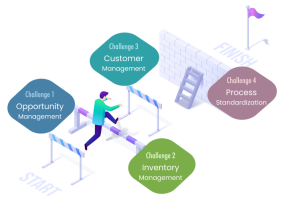Sales and marketing leaders often get torn between the merits of measuring marketing success over an extended period of time or quantifying it based on short-term results. These are certainly difficult questions and become even more complicated when uncertainty is high.
Not to forget that marketing professionals find it challenging to measure the effectiveness of their initiatives against the explosion of digital marketing, social networks, satellite radio, mobile marketing, and many other networks competing for customers’ attention.
Over the last decade, the marketing function has constantly been questioned about its ability to add value to the company commensurate with the efforts and inputs. Again, the concern of measuring the success of marketing initiatives in the short term or long term pops up.
Read on as we explore these challenges in more detail, present viable solutions, and emphasise the importance of the distributor channel in this space.
Challenges of Measuring Marketing Effectiveness
Since marketing is a dynamic field, there are a variety of facets that affect the results of marketing campaigns. The most common challenges in measuring the effectiveness of marketing function include:
- Time – Considering all content, campaigns, and channels that support marketing efforts is a very time-consuming task.
- Tools and data – It is typical to collect real-time data from multiple channels, and tools are required to do the job and aggregate the data to retrieve the results.
- Approach – Evaluating the best strategy to calculate the ROI of the marketing function is imperative.
- Skills – Finance, accounting, and analytics are the mandatory skills to measure marketing effectiveness.
- Frequency of data – Some marketing channels offer real-time data, whereas others only offer data after the campaign or provide weekly/monthly reports.
How to Measure Marketing Effectiveness Perfectly?
1. Define the Marketing Campaign and How Success Will Be Measured
Marketing campaigns are run across multiple platforms, including social media, emails, traditional media, and more, to attract maximum prospects. The marketing effectiveness of a campaign must be measured both in the context of short-term and long-term impacts on the cost of customer acquisition and revenues. The constant collection of real-time data helps ascertain the effectiveness of marketing strategies and customer lifetime value.
2. Define Marketing Channels
If the focus of analysis is on a single channel, it would be straightforward to measure the effectiveness of the marketing function. However, it is not possible to utilise a single channel in today’s omnichannel era. So, it is important to itemise the marketing channels and collect the information, relevant data, and feedback from the different channels to gain deep insights into marketing performance.
This also includes gathering real-time information and feedback from the distribution channel to validate and assess how the marketing message is being spread and perceived. The focus of the analysis should be on how channels are working together to spread the message and if the message is reaching the right set of prospects.
3. Capital Expenditure for Specific Marketing Channels
Tracking the capital expenses for specific marketing channels is essential to determine the actual cost of customer acquisition. Key performance indicators play an important role here. The KPIs can be broken down by week, month, or quarter. At every step, the data can be enriched and cross-referenced against past performance to ensure that the marketing campaign is on the right track. This can help evaluate the channel’s effectiveness in the context of customer conversions and paying customers.
4. Assess Short-Term and Long-Term Impact of Customer Lifetime Value on Revenue
Calculating the short-term impact on revenue is easier. On the contrary, the long-term impact is difficult to evaluate. Determining the long-term impact on revenue involves calculating customer lifetime value and retention rates.
Measuring Marketing Effectiveness in Distributor-led Sales
- The analysis of the distribution channel serves as an important component of the marketing function. As elucidated above, the assessment of the impact across touchpoints in the distribution channel can drive the understanding of marketing performance. To that end, here are some of the important themes to measure marketing effectiveness in distributor-led sales:
- Sales growth – to measure the ability of the team to increase revenue over a specific period. It compares realistic sales with the set revenue targets.
- Sales to date – measure the monthly or quarterly sales to indicate the actual business performance to evaluate whether the short-term marketing efforts are successful.
- Product sales performance – to measure the performance of the product based on total product revenue for the given time.
- Lead conversion rate – to indicate the percentage of sales leads that are converting to customers.
- New leads – to measure the new prospects for a given period. It determines the number of potential customers in the sales pipeline and the effectiveness of marketing campaigns.
- Sales representative performance – to measure the team performance. It includes average deal size, monthly sales, lead response time, conversion rate, and average days to close the deal.
Streamline Your Marketing Efforts with Us
As most businesses have become digital, it is imperative to keep your business updated to boost marketing performance and sales with an integrated digital system.
Catering to modern business needs, our on-demand platform can help you deliver faster and better services to customers across all industries. The distributor-level solution can directly keep pace with the outside world developments and provide a real-time overview of activities across departments from a centralised platform.
So, if you are also looking for the best tech-enabled marketing and distributor solutions, connect with us today.




